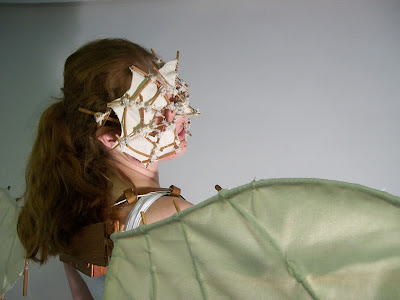*Tiny pewter nut which happened to have a convenient hole
for a hook not included*
Ever get tired of littering yourself with those annoying tiny pieces of walnut shell EVERY TIME you crack one open for that walnutty goodness inside? Here's a way to recycle it into a nifty little locket without half the mess. Providing you cracked it open with hours of delicacy with a small saw.
This one needs:
- A walnut (maybe a couple if it doesn't work the first time)
- a small saw
- a drill with a teenie tiny drill head
- Thin wire
- Thicker metal wire
- brass shim or other thin, easy to bend metal
- possibly a hammer and nail.
First you need to crack open that walnut. With a small saw carefully begin to work down the natural seam around the middle. Depending on the unique walnut, this can be easier or harder. It took me a good hour or so to do it the first time (going uber delicate), it didn't help that the first time it decided to crack the wrong way. Just be gentle with it and you'll get there eventually.
Eat that nut. Nom nom. If you're allergic to walnuts now proceed to inject your epipen and call your local emergency number. After that kerfuffle, proceed to carefully scrape out the inside of the nut with a knife or otherwise so you have the two empty shells.
Now to make that hinge. I used brass shim and tin for my versions, but any thin metal that can be easily cut, drilled and folded should be fine. To make the hinge I got two small strips of brass shim, cut twice to the middle and then folded two of the three 'fingers' over on either side of the middle, and then folded the middle down on the second. Then loosely folded over the other fingers so that there was a small gap:
Shown here in paper. Two cuts to middle
folded down tight/clamped
Loosely to make the loop
Trim down the ends to make the neat and you should get something that looks a bit like this:
Now you're going to need small holes in the hinges and the walnut shells. You could use the small drill and piece to make three sets of double holes, but I find that with brass (and thicker tin) it's better to just use a hammer and nail for the hinges. also thread a piece of wire metal through the loose loops to connect the hinges and, using pliers, bend the ends of it to keep it in place.
Holding the two walnut sides together, carefully aline the hinge where you want it to be and mark with a pen through the holes onto the walnut shells. Using the small drill carefully and very, very delicately drill with the correct sized head through the walnut shell where you marked it. While you're at it, using a bigger drill head, drill though the top of one where you're going to thread the string/necklace connecting wire/cotton/wool/thingamajig.
Using the pliers and thin metal wire, connect the hinges to the walnuts (twist and bend wire on the inside for security) and you should have something that looks a bit like this:
Thread some ribbon or string through the top and knot and now you have a little locket pendant where you can hold teenie tiny photos or teenie tiny pewter nuts or teenie tiny miscellaneous treasured stuff. It's also optional to put a little hook and latch on the other side just to keep it a little more secure if it doesn't close completely. Now you have you're own little walnut locket that lasts until the use-by date sets in... yeah I don't know what that is, but so far a locket made by a two year old walnut a year ago (yes, somehow I know it's that old) has lasted.
Estd. 2012



























